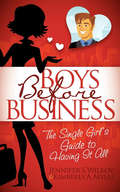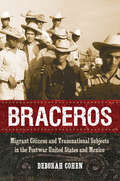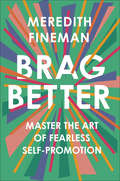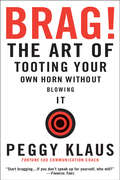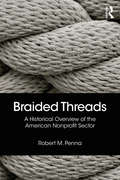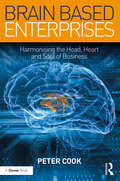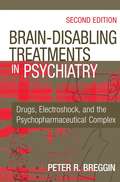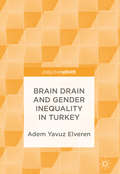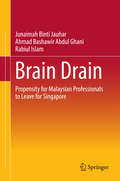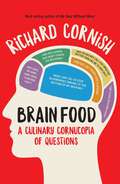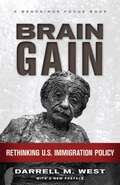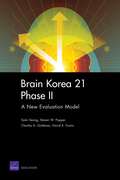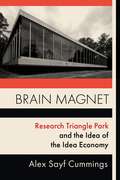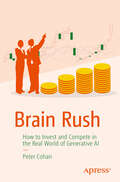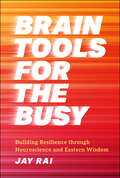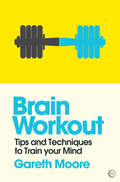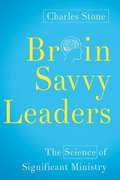- Table View
- List View
Boys Before Business: The Single Girl's Guide to Having It All
by Jennifer S. Wilkov Kimberly A. MyllsWhy do some women seem to have it all – the relationship, the career and the life of their dreams? Kim Mylls and Jennifer S. Wilkov know the answer and have cracked the code for how to live your extraordinary life. This controversial approach of putting your relationship with your man before your career is the magic formula. It’s possible to find your Prince Charming and have a fulfilling career. To do this, you’ll need to know what you want and you’ll need to put Boys Before Business. After finding their true loves using the principles in this book, Kim and Jennifer offer practical and straightforward advice on how to find your true love, have a great relationship, flourish in your career, and live the life you love. The tips and exercises in this book will not only inspire you but propel you into action. Kim and Jennifer are committed to helping women everywhere enjoy their lives by teaching you how to get clear about what you want, define the life you want to live, identify and find your Prince Charming, create an environment for your relationship to flourish, infuse your business and career with the tips, tools and techniques that make your relationships extraordinary, and commit to a life beyond what you've imagined. Whether you’re the single girl who’s never been married or if you’re divorced or widowed, if you’re looking for love and balance, and if you still want it all, this is the book for you. We’re excited to help you find the man of your dreams and live the life you love.
Braceros
by Deborah CohenAt the beginning of World War II, the United States and Mexico launched the bracero program, a series of labor agreements that brought Mexican men to work temporarily in U. S. agricultural fields. InBraceros, historian Deborah Cohen asks why these temporary migrants provoked so much concern and anxiety in the United States and what the Mexican government expected to gain in participating in the program. Cohen reveals the fashioning of a U. S. -Mexican transnational world, a world created through the interactions, negotiations, and struggles of the program's principal protagonists including Mexican and U. S. state actors, labor activists, growers, and bracero migrants. Cohen argues that braceros became racialized foreigners, Mexican citizens, workers, and transnational subjects as they moved between U. S. and Mexican national spaces. Drawing on oral histories, ethnographic fieldwork, and documentary evidence, Cohen creatively links the often unconnected themes of exploitation, development, the rise of consumer cultures, and gendered class and race formation to show why those with connections beyond the nation have historically provoked suspicion, anxiety, and retaliatory political policies.
Braddock Industries, Inc.
by William E. FruhanThis case examines the drivers of economic value creation for shareholders, and how these drivers are reflected in various incentive compensation programs for management. The case also looks at how the economic performance of business units can be evaluated using measures of economic value creation.
Bradley Marquez: Reduction in Force (A)
by Thomas J. Delong Vineeta VijayaraghavanThe Bradley Marquez advertising agency had created a successful niche delivering ethnic markets to their clients, corporate giants like Compaq, Sprint, Texaco, and British Airways. The company was operating in aggressive growth mode when, in 2000, the stock market bubble of the 1990s burst. Now, Andrew Lauder, chief operating officer, faces the possibility of a second round of layoffs and downsizing, "no longer cutting fat but cutting muscle," as Lauder puts it. Being a public company means that warning of upcoming layoffs would violate securities laws.
Bradley Marquez: Reduction in Force (B)
by Thomas J. Delong Vineeta VijayaraghavanSupplements the (A) case.
Brag Better: Master the Art of Fearless Self-Promotion
by Meredith FinemanThis effortless and unapologetic approach to self-promotion will manage your anxiety and allow you to champion yourself. Does talking about your accomplishments feel scary or icky because you're worried people will think you're "obnoxious"?Does it feel more natural to "put your head down and do the work"?Are you tired of watching the loudest people in your industry get disproportionate praise and rewards?If you answered "yes" to any of the above, you might be self-sabotaging. You need to learn to Brag Better. Meredith Fineman has built a career working with "The Qualified Quiet": smart people who struggle to talk about themselves and thus go underestimated or unrecognized. Now, she shares the surefire and anxiety-proof strategies that have helped her clients effectively communicate their achievements and skillsets to others.Bragging Better doesn't require false bravado, talking over people, or pretending to be more qualified than you are. Instead, Fineman advocates finding quiet confidence in your opinions, abilities, and background, and then turning up the volume. In this book, you will learn the career-changing tools she's developed over the past decade that make bragging feel easy, including: • Get remembered by focusing your personal brand and voice on key adjectives (like "effective, subtle, and edgy") • Practice explaining what you do in simple, sticky terms to earn respect and recognition from the public and people at work. • Eliminate words that undermine your work and find better ones--like your bio saying you're "trying" or "attempting" to do something instead that you ARE doing it.If you're ready to begin Bragging Better--to telling the truth about your accomplishments with grace and confidence--this book is for you.
Brag!: The Art of Tooting Your Own Horn without Blowing It
by Peggy KlausBrag! is a whip smart tool kit--one that tampers with our beliefs about humility by defining bragging as an act of authenticity. Peggy Klaus, a Fortune 500 communication coach, sharpened her strategies in Hollywood, "the bragging capitol of the world," where she learned the art of tooting your horn, without blowing it. "To brag is to talk about your best self with pride and passion in a conversational manner." explains Klaus.She includes a snappy "Bragging Dictionary" with highly practical techniques including instructions for the "Bragalogue," a brief memorable elevator pitch and a "Brag bag," the collection of your greatest hits with colorful details that can be easily accessed. Bragging rights and responsibilities are surveyed in a variety of situations:the co-worker who takes credit, techno-bragging online, performance reviews, job interviews and working a room. Klaus peppers her points with examples from her coaching sessions and seminars, sample dialogues and self-assessments. Although several examples may seem too studied, Klaus has much to brag about. This is a book that will change the way you think about the slippery skill of selling yourself. --Barbara Mackoff
Brahmin Capitalism
by Noam MaggorNoam Maggor shows how the moneyed elite in Gilded Age Boston leveraged their wealth to forge transcontinental networks of commodities, labor, and transportation. With the decline of cotton-based textile manufacturing, these gentleman bankers found new business opportunities in the mines, railroads, and industries of the Great West.
Braided Threads: A Historical Overview of the American Nonprofit Sector
by Robert M. PennaThe United States today supports the strongest, most varied nonprofit sector in the world, an economic force of about $2 trillion, responsible for 5.4% of the nation’s Gross Domestic Product in 2014, and accounting that year for 10.3% of the country's private-sector workforce. Roughly three-quarters of all households in America give to charity, with the average total donation being $2,030 annually. Yet for all this, few Americans, and more specifically, a surprisingly small proportion of the sector’s practitioners, know where the nonprofit sector came from, or how it developed and came to be what we know it as today. This work is a historical overview of that sector, presented less as a chronology than as a discussion of the major influences—some legal, some social, some political—that helped shape the arena. The core message of the book is that the developmental trajectory of nonprofits has not been a straight line. Rather, its path over the years might be compared to that of a pinball, moving straight and building up momentum for a time, but then ricocheting off some event or social trend and taking off in a new direction altogether. Equally important, however, the sector is also the product of a founding genome that came out of colonial, Puritan-inspired New England and spread as that culture and its values became one of the dominant forces in American society. Knowing this history is a prerequisite for understanding and appreciating the character of this deeply influential part of American social culture.
Brain Based Enterprises: Harmonising the Head, Heart and Soul of Business
by Peter CookBrain Based Enterprises offers a unique synthesis of intelligent thought fused with pragmatic and pithy insights on the art and discipline of leading enterprises, where intelligence, ideas and innovation are the currencies of Sustainable Coopetive Advantage (SCA). From the first signs of intelligence through making axes and fire, we now have access to unprecedented powers of creation through the convergence of humanity and technology. Rapid and dramatic advances in our understanding of genomics, biotechnology, computing and robotics make it possible for us to create a better world or destroy what we have created. The author explores both sides of the Man-Machine dynamic so that you can choose wisely. Expressed clearly and concisely, this book is essential reading for busy people seeking to inform and illuminate themselves with a rich mixture of pragmatism, inspiration and wisdom. Featuring numerous micro case-ettes from enterprises ranging from biotechnology to banking and bots, Brain Based Enterprises grounds the ideas for people seeking to make the most of the Fourth Industrial Revolution.
Brain Circuits for Social Networking: How Successful Iconoclasts Leverage Social Intelligence
by Gregory BernsA key driver of success for iconoclasts who consistently challenge conventional thinking is social intelligence, or the ability to sell your unconventional ideas to others. Connecting with noniconoclasts depends on two aspects of social intelligence: familiarity and reputation. Both functions can be understood through the circuits in the brain that implement them.
Brain Disabling Treatments in Psychiatry: Drugs, Electroshock, and the Psychopharmaceutical Complex
by Peter R. BregginFrom the author of "Toxic Psychiatry" and "Talking Back to Prozac" "Peter Breggin is the conscience of American psychiatry. Once more he updates us on the real evidence with respect to the safety and effectiveness of specific psychiatric medications and ECT. This information is needed by all mental health professionals, as well as patients and families. " --Bertram Karon, Ph. D. , Professor of Psychology, Michigan State University, Author of "The Psychotherapy of Schizophrenia". "Nowhere does false medical thinking do more harm than in the modern psychiatric argument that mental illness is easily diagnosed and then cured by a side-effect free drug. Nowhere is the correct psychiatric thinking more evident than in the books by Peter Breggin. " -- William Glasser, MD, psychiatrist, author of "Reality Therapy". In "Brain Disabling Treatments in Psychiatry," renowned psychiatrist Peter R. Breggin, M. D. , presents startling scientific research on the dangerous behavioral abnormalities and brain dysfunctions produced by the most widely used and newest psychiatric drugs such as Prozac, Paxil, Zoloft, Cymbalta, Effexor, Xanax, Ativan, Ritalin, Adderall, Concerta, Strattera, Risperdal, Zyprexa, Geodon, Abilify, lithium and Depakote. Many of Breggins earlier findings have improved clinical practice, led to legal victories against drug companies, and resulted in FDA-mandated changes in what the manufacturers must admit about their drugs. Yet reliance on these drugs has continued to escalate in the last decade, and drug company interests have overwhelmed psychiatric practice. This greatly expanded second edition, supported by the latest evidence-based research, shows that psychiatric drugs achieve their primary or essential effect by causing brain dysfunction, and that they tend to do far more harm than good. New scientific analyses in this completely updated edition include: Chapters covering every new antidepressant and stimulant drug Twenty new guidelines for how to conduct non-drug therapy A chapter describing how to safely withdraw from psychiatric drugs A discussion of "medication spellbinding," explaining how patients fail to appreciate their drug-induced mental dysfunctions Documentation of how the drug companies control research and the flow of information about psychiatric treatments.
Brain Drain and Gender Inequality in Turkey
by Adem Yavuz ElverenThis book provides a comprehensive analysis of the brain drain from Turkey, with particular focus on its gender dimension. The author presents a review of brain drain literature, as well as analyzing the brain drain from Turkey using original survey data. Presenting an account of state changes in Turkey, and using a range of empirical methods, the book argues that women have a higher tendency not to return to the country due to increasing gender inequality, borne out of a shift towards a more authoritarian regime over the last decade. Brain Drain and Gender Inequality in Turkey will be of interest to students and scholars across a range of disciplines, including migration studies, social policy, and gender studies.
Brain Drain: Propensity for Malaysian Professionals to Leave for Singapore (SpringerBriefs in Economics)
by Junaimah Binti Jauhar Ahmad Bashawir Abdul Ghani Rabiul IslamThis book focuses on skilled labour migration from Malaysia to Singapore. In this regard, it examines a number of variables such as Better Perks and Benefits, Quality of Work Life, Ease of Immigration Procedures, International Exposure, Greater Job Availability, and Social Networks, and how they influence the decisions of Malaysian accounting professionals. In doing so, the book elaborates on how this phenomenon is an indirect result of globalization, which is predominantly detrimental for developing countries such as Malaysia. The book also highlights the need for these experts in their home country, as Malaysia is currently striving to improve its economy in order to achieve high-income status by 2020.
Brain Food
by Richard CornishIs pork butt the new pork belly? Whose room temperature are we talking about? And can you freeze cheese? (Yes, but why would you want to?) These are some of the burning questions at the heart of every kitchen. Food science, etiquette, mythbusting, history and common sense—there is no subject too big or too small for Richard Cornish to answer in his weekly Brain Food columns, which have been must-reads for years. Brain Food is a collection of the best cooks' conundrums and their surprising answers.
Brain Gain: Rethinking U.S. Immigration Policy
by Darrell M. WestMany of America's greatest artists, scientists, investors, educators, and entrepreneurs have come from abroad. Rather than suffering from the "brain drain" of talented and educated individuals emigrating, the United States has benefited greatly over the years from the "brain gain" of immigration. These gifted immigrants have engineered advances in energy, information technology, international commerce, sports, arts, and culture. To stay competitive, the United States must institute more of an open-door policy to attract unique talents from other nations. Yet Americans resist such a policy despite their own immigrant histories and the substantial social, economic, intellectual, and cultural benefits of welcoming newcomers. Why?In Brain Gain, Darrell West asserts that perception or "vision" is one reason reform in immigration policy is so politically difficult. Public discourse tends to emphasize the perceived negatives. Fear too often trumps optimism and reason. And democracy is messy, with policy principles that are often difficult to reconcile.The seeming irrationality of U.S. immigration policy arises from a variety of thorny and interrelated factors: particularistic politics and fragmented institutions, public concern regarding education and employment, anger over taxes and social services, and ambivalence about national identity, culture, and language. Add to that stew a myopic (or worse) press, persistent fears of terrorism, and the difficulties of implementing border enforcement and legal justice.West prescribes a series of reforms that will put America on a better course and enhance its long-term social and economic prosperity. Reconceptualizing immigration as a way to enhance innovation and competitiveness, the author notes, will help us find the next Sergey Brin, the next Andrew Grove, or even the next Albert Einstein.
Brain Korea 21 Phase II
by Steven W. Popper Somi Seong David K. Evans Charles A. GoldmanThe Brain Korea 21 Program (BK21), which seeks to make Korean research universities globally competitive and to produce more high-quality researchers in Korea, provides funding to graduate students and professors who belong to research groups at top universities. The authors develop quantitative and qualitative models to evaluate how well BK21 is fulfilling its goals and make suggestions for further stimulating Korean university research.
Brain Magnet: Research Triangle Park and the Idea of the Idea Economy (Columbia Studies in the History of U.S. Capitalism)
by Alex CummingsBeginning in the 1950s, a group of academics, businesspeople, and politicians set out on an ambitious project to remake North Carolina’s low-wage economy. They pitched the universities of Raleigh, Durham, and Chapel Hill as the kernel of a tech hub, Research Triangle Park, which would lure a new class of highly educated workers. In the process, they created a blueprint for what would become known as the knowledge economy: a future built on intellectual labor and the production of intellectual property.In Brain Magnet, Alex Sayf Cummings reveals the significance of Research Triangle Park to the emergence of the high-tech economy in a postindustrial United States. She analyzes the use of ideas of culture and creativity to fuel economic development, how workers experienced life in the Triangle, and the role of the federal government in bringing the modern technology industry into being. As Raleigh, Durham, and Chapel Hill were transformed by high-tech development, the old South gave way to a distinctly new one, which welded the intellectual power of universities to a vision of the suburban good life. Cummings pinpoints how the story of the Research Triangle sheds new light on the origins of today’s urban landscape, in which innovation, as exemplified by the tech industry, is lauded as the engine of economic growth against a backdrop of gentrification and inequality. Placing the knowledge economy in a broader cultural and intellectual context, Brain Magnet offers vital insight into how tech-driven development occurs and the people and places left in its wake.
Brain Plasticity and Learning: Implications for Educational Practice
by Jennifer Anne HawkinsThis book synthesizes the latest findings on neuroplasticity and learning, drawing on rich phenomenological research carried out with teachers, psychologists, parents and students from around the world to examine the implications for current teaching and for the advancement of learning methods. Building on the author’s previous work in this area, the volume considers in depth the function of feelings and emotions in neuroplastic cognition, and provides an analysis of curriculum debates and assessment systems in the light of neuroplasticity. The final chapters explore the implications of brain plasticity outside of structured learning environments and in society at large. The book will appeal to students and scholars of psychology and education, as well as to educational psychologists, coaches, teachers and educational leaders.
Brain Rush: How to Invest and Compete in the Real World of Generative AI
by Peter CohanAfter decades of false starts, artificial intelligence (AI) is entering the mainstream of society. That is largely due to the rapid adoption of ChatGPT, a service that responds to almost any natural language question with cogent paragraphs. ChatGPT is the leading example of generative AI -- technology that creates original text, images, video and computer code based on uncovering patterns in training data. The book will explain how generative AI works and how much economic value it could create and will map out the industry value network. For each value network stage, the book will define the industry, estimate its size, growth rate, and profit potential, identify the most successful participants, and explain how they have achieved their success and where they will compete in the future. The book will conclude with a section on what investors and business leaders should do to make an informed decision on where to place their bets.What You Will LearnInsights on how best to assemble the resources – whether by hiring a consultant or bringing on board a generative AI expert -- to build, train, and operate company specific generative AI applicationsHow management can brainstorm, evaluate and execute the right opportunitiesConcepts and processes to enable investors to place bets with the highest risk-adjusted returnsWho This Book is ForBusiness and enterprises seeking to get value from generative AI, current or potential suppliers of technology and services to companies that build generative AI, and venture capitalists and public equity investors seeking to make profitable bets on generative AI companies
Brain Science, Peak Performance, and Finding the Shine: Inspiring Excellence in Yourself and Your People-Every Day
by Edward M. HallowellYour job as a manager is getting harder all the time. Especially in today's world of intensifying competition and economic uncertainty, the people who work for you need to shine their brightest every day. In this chapter, bestselling author and practicing psychiatrist Edward Hallowell introduces the Cycle of Excellence, a process he created to help managers inspire peak performance. Based on brain science, performance research, and Hallowell's own clinical experience, the Cycle of Excellence consists of five steps: (1) Select: put the right people in the right jobs; (2) Connect: strengthen the interpersonal bonds among your team members; (3) Play: help people unleash their imaginations at work; (4) Grapple and Grow: when the pressure's on, enable employees to achieve mastery of their work; and (5) Shine: use the right rewards to promote loyalty and stoke your people's desire to excel. After briefly describing each of the five steps, Hallowell explains the evolution of his approach and how new research in three areas-neuroscience, positive psychology, and the connection between happiness and achievement-catalyzed his thinking. This chapter was originally published as the Introduction to "Shine: Using Brain Science to Get the Best from Your People."
Brain Tools for the Busy: Building Resilience through Neuroscience and Eastern Wisdom
by Jay RaiSupercharge your resilience, energy and productivity without cramming another task into your already chaotic schedule Brain Tools for the Busy: Building Resilience through Neuroscience and Eastern Wisdom is an essential guide for those navigating the demanding challenges of their busy lives, without the luxury of slowing their pace. Guided by neuroscience expert and renowned executive coach Jay Rai, this work serves as your framework for mastering resilience. Dive into a heady mix of modern neuroscience, transformative psychotherapies, and timeless Eastern philosophies. Expect no fluff and jargon; this is your go-to manual for practical, implementable strategies that forge a steely mindset and fend off burnout in our relentless, always-on-the-move existence. Brain Tools for the Busy arms you with simple, effective techniques to strengthen your mental health, conquer stress, and skyrocket work performance—strategies so intuitive you can start using them instantly. In addition, you will uncover: The science and strategies of crafting a resilient mindset and beating burnout Techniques to amplify self-confidence, nurture self-compassion and empathy, and sharpen your assertiveness Tactics to handle conflict like a pro, preserving and repairing those all-important professional and personal relationships Whether you're an entry-level professional, a seasoned C-suite exec, or somewhere in between, Brain Tools for the Busy is a must-have resource for managers, executives, directors, entrepreneurs, founders, and other business leaders determined to stay on top of their game.
Brain Workout: Tips and Techniques to Train your Mind
by Gareth MooreUse it or lose it! Your mind needs exercise to stay in top condition, just as your body does. By working up a cerebral sweat in this ‘mental gymnasium’ you will soon have a lean, mean thinking machine on your shoulders.Your mind is what makes you tick, so keeping it in tip-top condition is as important as taking care of your body. By performing mental workouts you can build your brain power and keep your mind alert and agile well into old age. Brain Workout offers a mental gymnasium to keep your brain in trim. Here are dozens of tips for building up your mental muscles, as well as a program of exercises from gentle limbering-up to more complex challenges.Learn to hone your logical reasoning, number and word skills, pattern recognition, short- and long-term memory, comprehension, creative thinking, problem-solving, and much else besides. The exercises are fun to do and carefully devised to ensure you make progress across the whole spectrum of abilities. Self-testing enables you to assess your performance – you can learn as much from being wrong as from being right! Working systematically through the book, in no time you’ll be boosting your brain to peak efficiency. Get up to speed with Brain Workout. Stretch yourself to new limits. Give yourself the chance to excel.
Brain-Savvy Leaders: The Science of Significant Ministry
by Charles StoneLeadershipdemands constant reframing and reappraisal of the situation at hand. Itrequires focus, objectivity, honest appraisal of self and others, andevaluation of available resources. An effective Christian church leadermust also align the congregation’s vision and practices with God’svision and the teachings of Christ. Perhaps most importantly, the churchleader must love others.AuthorCharles Stone uses recent neuroscience research to show how basic brainprocesses affect leadership. He writes in layperson’s language, withmemory-boosting illustrations and acronyms, helping readers to increaseproductivity, handle stress, create and sustain healthy teams, andmanage change in the church. Brain science complements and reinforcesChristian teaching on life and leadership; Brain-Savvy Leaders equips readers to use that science as a tool for improvement for life and for the church. Brain-Savvy Leaders is……the best book I have read on the brain science of healthy thinking andeffective leadership. Dr. Stone has done an incredible job of balancingmodern brain science with Biblical truth, making complex ideas simple tounderstand and providing practical tools to enhance mental performance.--Timothy R. Jennings, M.D, FAPA; President, Tennessee PsychiatricAssociation; Vice President, Southern Psychiatric Association; author, The God Shaped Brain: How Changing Your View of God Transforms Your Life…an engaging and fun read that's also insightful, informative, andpractical. A valuable resource for spiritual leaders. --Golnaz Tabinia,neuroscientist and assistant professor, Carnegie Mellon University…will help you with emotional regulation, personal productivity, teamcollaboration and change management. It's a winner! --Dan Reiland,Executive Pastor, 12Stone Church, Lawrenceville, Georgia; author, Amplified Leadership…shares helpful tips on how to master leadership in the church. I neededthis book. --Ron Edmondson, Senior Pastor, Immanuel Baptist Church,Lexington, Kentucky…can help you take your church to the next level and help you betteralign your leadership with God's desires. It will help you achievegreater focus and design more cohesive and collaborative teams. I highlyrecommend it. --Jeffrey M. Schwartz, M.D., author of You Are Not Your Brain and Brain Lock

